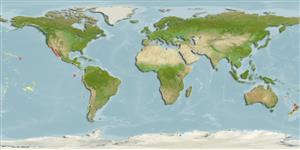>
Blenniiformes (Blennies) >
Blenniidae (Combtooth blennies) > Salariinae
Etymology: Hypsoblennius: Greek, hypsi = high + Greek, blennios = mucus (Ref. 45335).
More on author: Girard.
Environment: milieu / climate zone / depth range / distribution range
Οικολογία
Θαλασσινό(ά); Υφάλμυρο βενθικό(ς); εύρος βάθους 0 - 25 m (Ref. 37955), usually ? - 10 m (Ref. 56052). Subtropical; 37°N -
Eastern Central Pacific: Monterey Bay, California, USA to Bahia Magdalena (Baja California Sur, Mexico) and the Gulf of California.
Μέγεθος / Βάρος / Age
Maturity: Lm ? range ? - ? cm
Max length : 15.0 cm TL αρσενικό/απροσδιόριστο; (Ref. 2850); μεγ. αναφερόμενη ηλικία: 7 έτη (Ref. 56052)
Adults are found in intertidal shallows (Ref. 11482). Territorial (Ref. 37955). They feed on small benthic invertebrates and algae (Ref. 37955). Demersal spawners in nearshore habitats (Ref. 56049). Oviparous (Ref. 205). Eggs are demersal and adhesive (Ref. 205), and are attached to the walls of the parent's shelter. Eggs are brooded by the male parent (Ref. 56053).
Oviparous, distinct pairing (Ref. 205). Female deposits the eggs in protected areas. The male guards the eggs until hatching (Ref. 37955).
Eschmeyer, W.N., E.S. Herald and H. Hammann, 1983. A field guide to Pacific coast fishes of North America. Boston (MA, USA): Houghton Mifflin Company. xii+336 p. (Ref. 2850)
IUCN Red List Status (Ref. 130435)
Threat to humans
Harmless
Human uses
αλιεία: Εμπορικό(ά); Ενυδρείο: Εμπορικό(ά)
Εργαλεία
Special reports
Download XML
Διαδικτυακές πηγές
Estimates based on models
Preferred temperature (Ref.
123201): 16.2 - 25.9, mean 21 °C (based on 201 cells).
Phylogenetic diversity index (Ref.
82804): PD
50 = 0.5000 [Uniqueness, from 0.5 = low to 2.0 = high].
Bayesian length-weight: a=0.00832 (0.00454 - 0.01523), b=3.02 (2.86 - 3.18), in cm total length, based on LWR estimates for this species & (Sub)family-body (Ref.
93245).
Τροφικό Επίπεδο (Ref.
69278): 2.7 ±0.24 se; based on food items.
Ελαστικότητα (Ref.
120179): Μεσαίο(α), ελάχιστος χρόνος για διπλασιασμό πληθυσμού 1,4 - 4,4 έτη (tmax=6.5).
Fishing Vulnerability (Ref.
59153): Low vulnerability (10 of 100).
